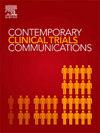Increasing Resiliency in U.S. Air Force Personnel: A Multi-Site Trial Protocol
IF 1.4
Q4 MEDICINE, RESEARCH & EXPERIMENTAL
引用次数: 0
Abstract
The purpose of this study is to examine the efficacy of the Stress Management and Resilience Training (SMART) in increasing the resilience of U.S. Air Force personnel. We aim to recruit up to 500 active component Air Force personnel and provide a two-arm randomization modality to make SMART more accessible and adaptive to the personnel's schedules. Two-arm randomization will be used to assign three sites for participants to choose in-person or computer-based training (CBT) and two sites where participants are randomized into their training type (in-person or CBT). The use of two-arm randomization will enable the examination of the difference between real-world settings within the framework of causal inference, as well as, differences based upon self-selection and a randomized control trial. We propose to examine the intervention effects at 12, 24 and 36-weeks post-intervention. Initial analysis will include descriptive statistics to characterize demographic status, military grade, duty location, and military occupation. The objectives of our analyses will include testing and estimating the intervention effects by comparing pre-post intervention changes in resilience, stress, anxiety, and QoL at each follow-up. Scores will also be pooled to test for overall intervention effects over time. Intervention effectiveness will be reported by comparing mean or median effects using 95 % confidence intervals and effect size estimates. An analysis of the longitudinal trend over the study period will be conducted by simultaneously examining data from all follow-ups using mixed-effects models in which random effects will be used to characterize between and within-subject variations.
增加美国空军人员的弹性:多站点试验协议
本研究的目的是检验压力管理和弹性训练(SMART)在提高美国空军人员弹性方面的效果。我们的目标是招募多达500名现役空军人员,并提供双臂随机化模式,使SMART更易于访问和适应人员的日程安排。两组随机试验将分配三个地点供参与者选择面对面或基于计算机的培训(CBT),另外两个地点随机分配参与者的培训类型(面对面或CBT)。双臂随机化的使用将能够在因果推理的框架内检查现实世界设置之间的差异,以及基于自我选择和随机对照试验的差异。我们建议在干预后12周、24周和36周检查干预效果。初步分析将包括描述性统计,以描述人口状况、军事职等、工作地点和军事职业。我们分析的目的将包括通过比较每次随访时干预前后心理弹性、压力、焦虑和生活质量的变化来测试和估计干预效果。分数也将汇集起来,以测试随着时间推移的整体干预效果。干预效果将通过比较使用95%置信区间和效应大小估计的平均或中位数效应来报告。研究期间的纵向趋势分析将通过使用混合效应模型同时检查所有后续调查的数据来进行,其中随机效应将用于表征受试者之间和受试者内部的变化。
本文章由计算机程序翻译,如有差异,请以英文原文为准。
求助全文
约1分钟内获得全文
求助全文
来源期刊

Contemporary Clinical Trials Communications
Pharmacology, Toxicology and Pharmaceutics-Pharmacology
CiteScore
2.70
自引率
6.70%
发文量
146
审稿时长
20 weeks
期刊介绍:
Contemporary Clinical Trials Communications is an international peer reviewed open access journal that publishes articles pertaining to all aspects of clinical trials, including, but not limited to, design, conduct, analysis, regulation and ethics. Manuscripts submitted should appeal to a readership drawn from a wide range of disciplines including medicine, life science, pharmaceutical science, biostatistics, epidemiology, computer science, management science, behavioral science, and bioethics. Contemporary Clinical Trials Communications is unique in that it is outside the confines of disease specifications, and it strives to increase the transparency of medical research and reduce publication bias by publishing scientifically valid original research findings irrespective of their perceived importance, significance or impact. Both randomized and non-randomized trials are within the scope of the Journal. Some common topics include trial design rationale and methods, operational methodologies and challenges, and positive and negative trial results. In addition to original research, the Journal also welcomes other types of communications including, but are not limited to, methodology reviews, perspectives and discussions. Through timely dissemination of advances in clinical trials, the goal of Contemporary Clinical Trials Communications is to serve as a platform to enhance the communication and collaboration within the global clinical trials community that ultimately advances this field of research for the benefit of patients.
 求助内容:
求助内容: 应助结果提醒方式:
应助结果提醒方式:


